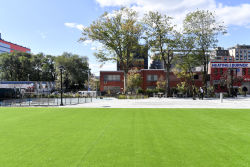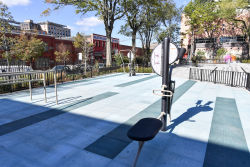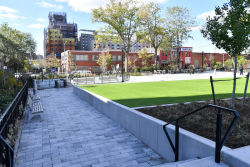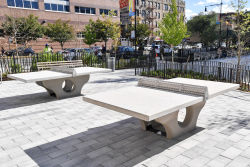Evelina Antonetty Playground
Evelina Antonetty Playground
What was here before?
In the 1930s, the Interborough Rapid Transit Company used this site for storage of materials used in subway operations. It also contained a field office of the Board of Transportation.
For several decades, this playground was adjacent to P.S. 31, later named William Lloyd Garrison School after the 19th-century abolitionist. Often called “The Castle on the Concourse” the school was designed in the Collegiate Gothic style by C. B. J. Snyder and constructed between 1897 and 1899. It was designated a New York City Historic Landmark in 1986. However, the school closed in 1997 as the building was deemed structurally unsound and was demolished in 2016.
How did this site become a playground?
This property was acquired by the City in two parcels by purchase and one parcel by condemnation in 1913. The land was assigned to Parks in 1934 and the playground opened in 1936. It was temporarily closed during the widening of the Grand Concourse and reopened in 1940. In 1987, it was named Garrison Playground.
In 1996, the playground’s handball and basketball courts, play equipment, concrete play areas, benches, and other infrastructure were upgraded. The playground was reconstructed in 2020 through the Community Parks Initiative – a multi-faceted program to increase the accessibility and quality of parks throughout the five boroughs in an equitable manner. The redesign included a walkway connecting Grand Concourse with Walton Avenue, new seating and fitness areas, a water feature, two flex performance spaces, an elevated lawn with synthetic turf, table tennis, spray showers, and play features.
Who is this playground named for?
This playground was renamed in 2020 in honor of community organizer and activist Evelina Antonetty (1922-1984).
Born in Salinas, Puerto Rico, Antonetty was sent to New York alone by boat in 1933 to live with relatives in East Harlem. She expressed an early interest in community activism as a teenager, working for Congressman Vito Marcantonio and labor organizer Jesús Colón. She moved to the South Bronx in the 1940s and was employed with a workforce preparedness program of District 65 of the United Auto Workers before marrying and becoming a mother to three children.
In the early 1960s, Antonetty became involved with the parents’ association at her children's school, advocating for bilingual instruction, better quality education and services, and more community involvement. In 1965, she founded United Bronx Parents, which became a pivotal grassroots organization in the South Bronx. Over time, UBP’s mission expanded beyond advocating for better education in public schools to become a provider of a wide range of social services and educational and leadership programs for youth and adults. In 2011, UBP became part of the Acacia Network, a national social service organization.
Antonetty served as UBP’s executive director until her death in 1984. She advocated for the creation of Hostos Community College, which shares the same block as this playground.
Check out your park's Vital Signs
Clean & Safe
Green & Resilient
Empowered & Engaged Users
Share your feedback or learn more about how this park is part of a
Vital Park System




